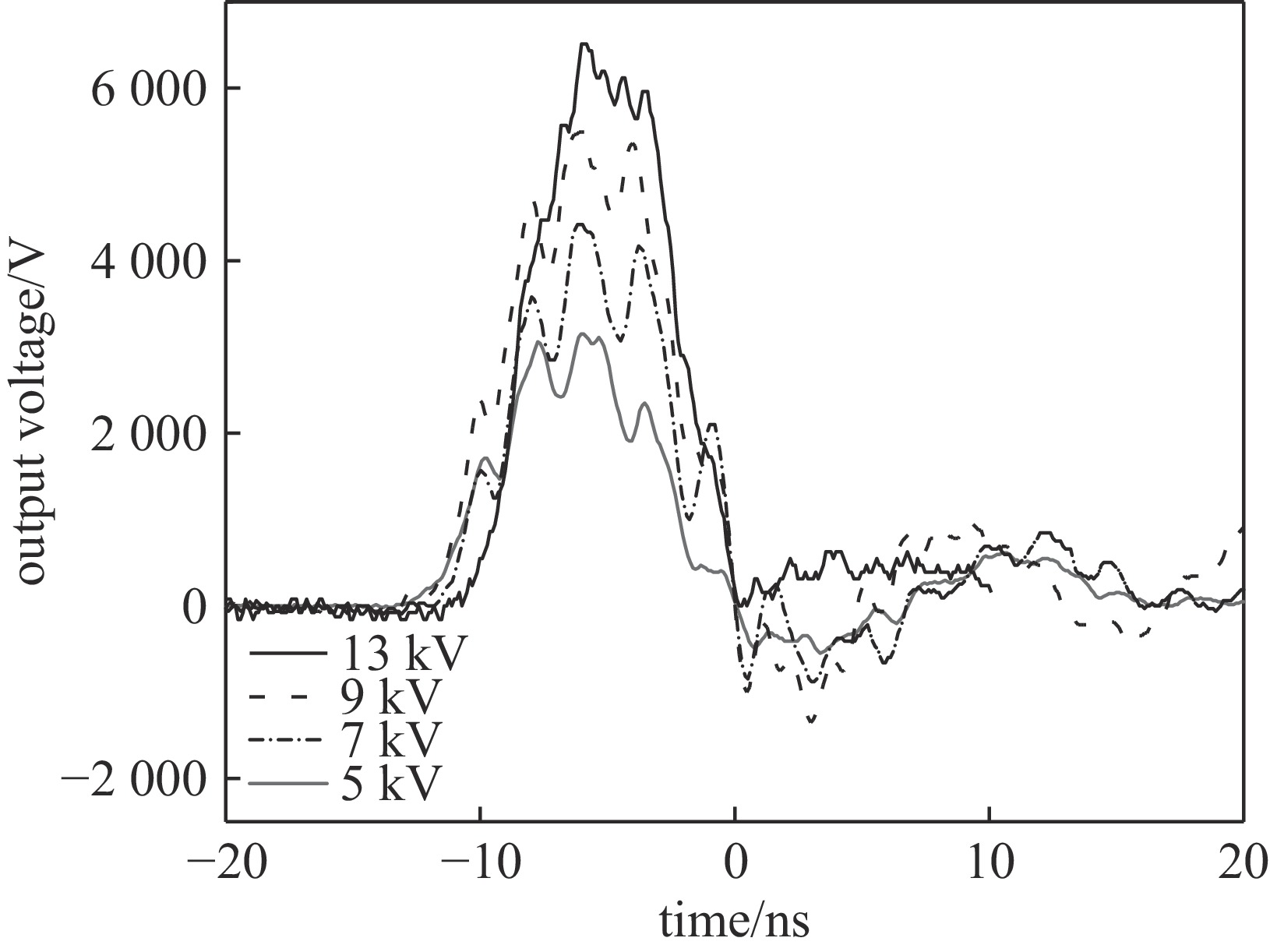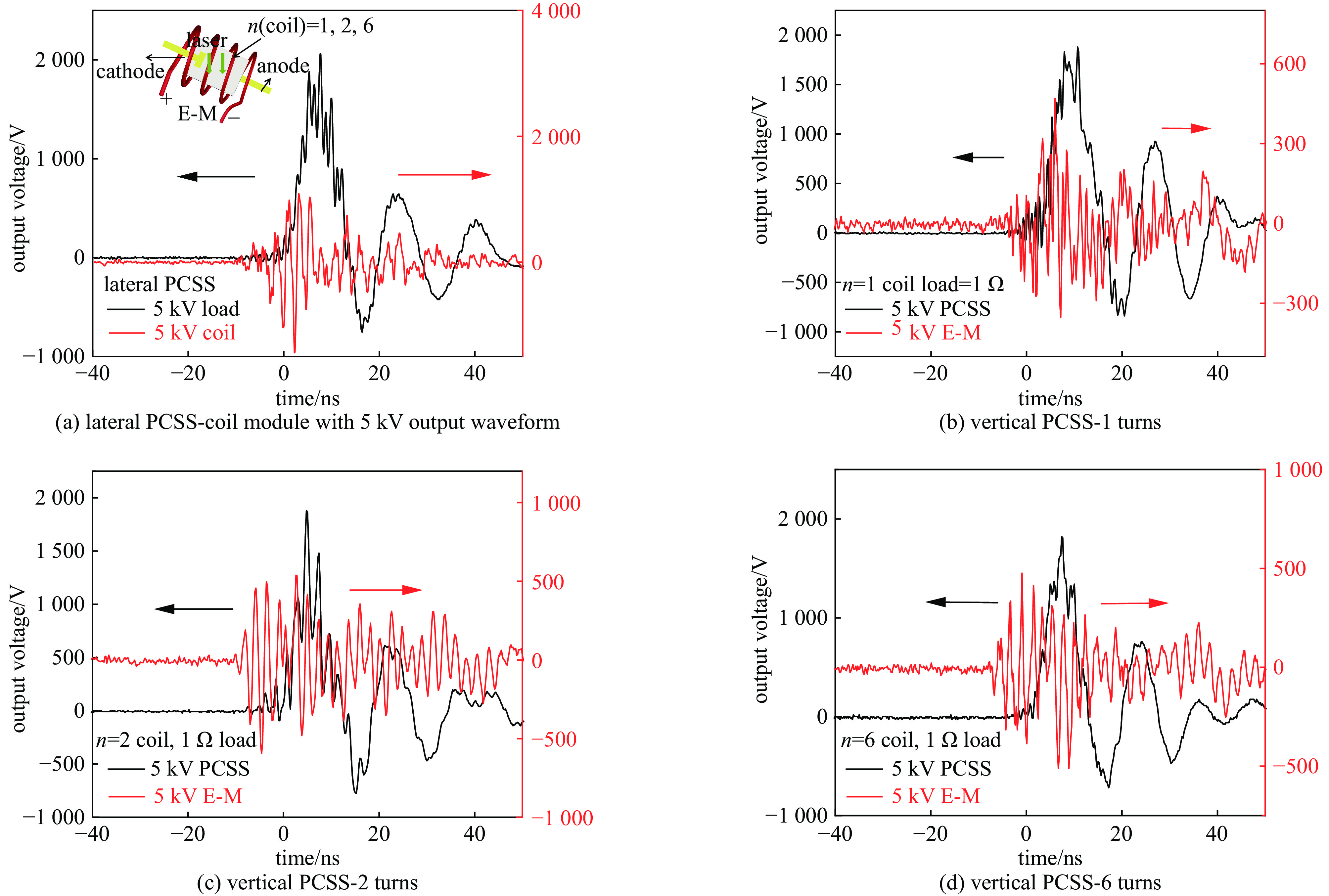A new electromagnetic oscillation phenomenon on vanadium-compensation semi-insulating 4H-SiC PCSS
-
摘要:
通过构建光导开关-金属线圈结构,发现了一种关于钒掺光导开关的电磁振荡现象。这种结构中光导开关响应于激光脉冲信号,金属线圈同时感应出振荡的脉冲信号。这种振荡信号的产生与输入偏压、激光能量、脉冲电路元件、光导开关的形状及结构无关,而与开关的输出特性有关。使用光导天线中的电流瞬冲模型可以较好地解释这一物理现象,通过在SiC半导体上制备欧姆接触电极形成光导开关,当超快激光脉冲照射材料表面时生成大量的光生载流子,同时在电极之间施加偏压信号。此时开关内部在电场作用下形成瞬态电流,进而形成电偶极结构,辐射出电磁波,金属线圈接收并产生振荡信号。
Abstract:Constructing a photoconductive semiconductor switch (PCSS)-metal coil structure, we discovered a new phenomenon of electromagnetic oscillation in vanadium-compensation semi-insulating (VCSI) PCSS. Here the PCSS responds to laser pulse and high-voltage signal while the metal coil generates an oscillating voltage pulse envelope signal. The generation of this oscillating signal is not related to the input bias voltage of the PCSS, the pulse circuit components, or the electrode structure of the PCSS, rather it is related to the output characteristic of the PCSS. This physical phenomenon can be explained using the current surge model in photoconducting antenna. Preparing ohmic contact electrode on the silicon carbide material forms the PCSS, which generates a large number of photogenerated carriers when ultra-fast laser pulses irradiate the surface of the material and Simultaneously applies a bias voltage signal between the electrode. At this time inside the PCSS the electric field causes the transient current, radiating electromagnetic wave to the metal coil to generate oscillating signal.
-
Key words:
- VCSI 4H-SiC /
- PCSS /
- electromagnetic oscillation /
- current surge model
-
Table 1. Vertical PCSS test parameters
Vin/kV Vmax/V Imax/A 3 1960 39.2 5 3152 63.04 7 4423 88.46 9 5490 109.8 11 5882 117.6 13 6823 136.46 Table 2. PCSS-Different turns coil test Parameters recorded in
Vin/kV n Vmax/V Imax/A Vmax+c/V N 5 1 2745 54 1070 13 5 2 2530 50 1540 10 5 6 2745 54 186 12 10 1 5713 114 2790 13 10 2 5061 101 2980 10 10 6 5647 112 489 13 -
[1] Akiyama H, Katsuki S, Redondo L, et al. Pulsed power technology[M]//Akiyama H, Heller R. Bioelectrics. Tokyo: Springer, 2017: 41-107. [2] Shen Yi, Wang Wei, Liu Yi, et al. A compact 300 kV solid-state high-voltage nanosecond generator for dielectric wall accelerator[J]. Review of Scientific Instruments, 2015, 86: 055110. doi: 10.1063/1.4921396 [3] Avgustinovich V A, Artemenko S N, Igumnov V S, et al. Forming nanosecond microwave pulses by transformation of resonant cavity mode[J]. IEEE Transactions on Microwave Theory and Techniques, 2016, 64(5): 1607-1613. doi: 10.1109/TMTT.2016.2549278 [4] Mi Yan, Xu Jin, Yao Chenguo, et al. Electroporation modeling of a single cell exposed to high-frequency nanosecond pulse bursts[J]. IEEE Transactions on Dielectrics and Electrical Insulation, 2019, 26(2): 461-468. doi: 10.1109/TDEI.2018.007777 [5] Chu Xu, Liu Jinliang, Xun Tao, et al. MHz repetition frequency, hundreds kilowatt, and sub-nanosecond agile pulse generation based on linear 4H-SiC photoconductive semiconductor[J]. IEEE Transactions on Electron Devices, 2022, 69(2): 597-603. doi: 10.1109/TED.2021.3138950 [6] Sullivan J S. High power operation of a nitrogen doped, vanadium compensated, 6H-SiC extrinsic photoconductive switch[J]. Applied Physics Letters, 2014, 104: 172106. doi: 10.1063/1.4875258 [7] Wang Wei, Xia Liansheng, Chen Yi, et al. Research on synchronization of 15 parallel high gain photoconductive semiconductor switches triggered by high power pulse laser diodes[J]. Applied Physics Letters, 2015, 106: 022108. doi: 10.1063/1.4906035 [8] Zetterling C M. Process technology for silicon carbide devices[M]. Stevenage: IET, 2002. [9] Doǧan S, Teke A, Huang D, et al. 4H-SiC photoconductive switching devices for use in high-power applications[J]. Applied Physics Letters, 2003, 82(18): 3107-3109. doi: 10.1063/1.1571667 [10] Wu Qilin, Zhao Yuxin, Xun Tao, et al. Initial test of optoelectronic high power microwave generation from 6H-SiC photoconductive switch[J]. IEEE Electron Device Letters, 2019, 40(7): 1167-1170. doi: 10.1109/LED.2019.2918954 [11] Luan Chongbiao, Li Boting, Zhao Juan, et al. A new phenomenon in semi-insulating 4H-SiC photoconductive semiconductor switches[J]. IEEE Transactions on Electron Devices, 2018, 65(1): 172-175. doi: 10.1109/TED.2017.2777600 [12] Wang Langning, Chu Xu, Wu Qilin, et al. Effects of high-field velocity saturation on the performance of V-doped 6H silicon-carbide photoconductive switches[J]. IEEE Journal of Emerging and Selected Topics in Power Electronics, 2021, 9(4): 4879-4886. doi: 10.1109/JESTPE.2020.3038561 [13] Xiao Longfei, Yang Xianglong, Duan Peng, et al. Effect of electron avalanche breakdown on a high-purity semi-insulating 4H-SiC photoconductive semiconductor switch under intrinsic absorption[J]. Applied Optics, 2018, 57(11): 2804-2808. doi: 10.1364/AO.57.002804 [14] Sun Xun, Xiao Longfei, Luan Chongbiao, et al. Low on-resistance and high peak voltage transmission efficiency based on high-purity 4H-SiC photoconductive semiconductor switch[J]. IEEE Transactions on Power Electronics, 2024, 39(2): 2013-2019. doi: 10.1109/TPEL.2023.3320124 [15] Qin Yan, Luan Chongbiao, Xiao Longfei, et al. Investigating the performance of a lateral 4H-SiC photoconductive switch with a sinking-electrode structure[J]. IEEE Transactions on Electron Devices, 2024, 71(1): 727-732. doi: 10.1109/TED.2023.3335915 [16] Zhu Li, Hu Long, Shen Xin, et al. Improved current and jitter performances of photoconductive semiconductor switch based on reduced graphene oxide/metal electrode[J]. IEEE Electron Device Letters, 2023, 44(2): 289-292. doi: 10.1109/LED.2022.3227174 [17] Zheng Zhong, Huang Wei, Han Weiwei, et al. Analyzing the effects of aluminum-doped ZnO and Ag layers for the transparent electrode vertical PCSS[J]. IEEE Transactions on Electron Devices, 2020, 67(6): 2414-2417. doi: 10.1109/TED.2020.2989244 [18] Cao Penghui, Huang Wei, Guo Hui, et al. Performance of a vertical 4H-SiC photoconductive switch with AZO transparent conductive window and silver mirror reflector[J]. IEEE Transactions on Electron Devices, 2018, 65(5): 2047-2051. doi: 10.1109/TED.2018.2815634 [19] Darrow J T, Zhang X C, Auston D H, et al. Saturation properties of large-aperture photoconducting antennas[J]. IEEE Journal of Quantum Electronics, 1992, 28(6): 1607-1616. doi: 10.1109/3.135314 [20] Piao Zhisheng, Tani M, Sakai K. Carrier dynamics and terahertz radiation in photoconductive antennas[J]. Japanese Journal of Applied Physics, 2000, 39: 96. -





 下载:
下载:








